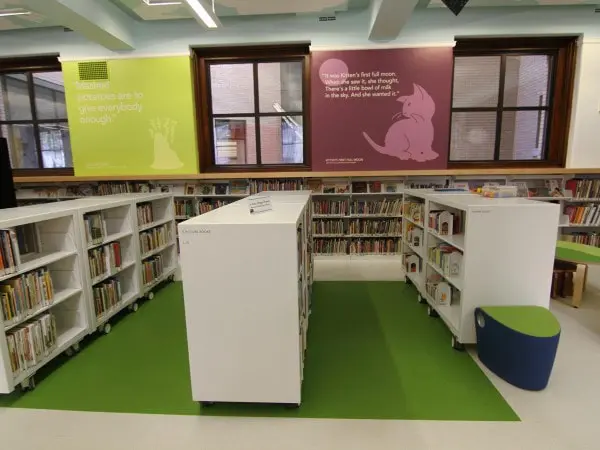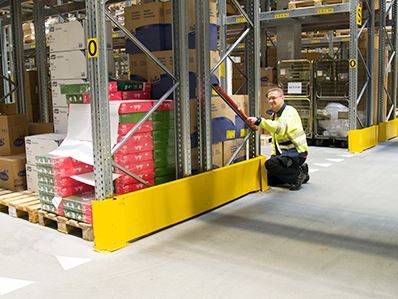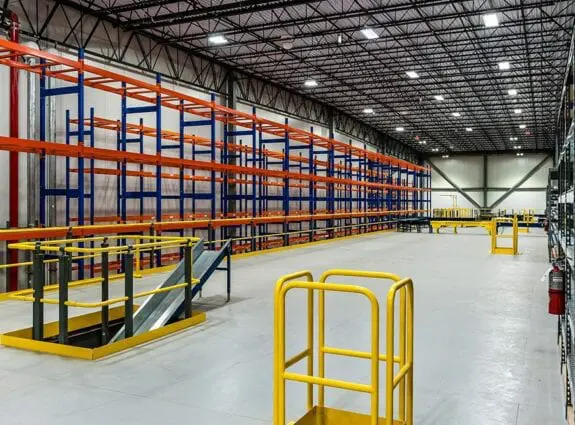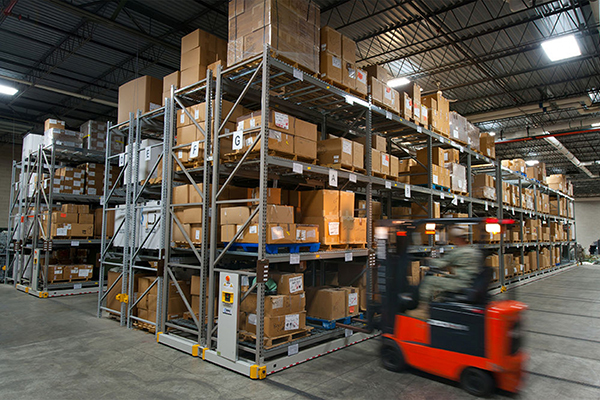
Libraries have always been an integral part of our communities, serving as centers of knowledge, learning, and exploration. As libraries continue to serve a growing population, the need for efficient storage solutions becomes more pronounced. Libraries are faced with the challenge of maximizing their storage space while providing easy access to resources and maintaining an organized environment. Innovative storage solutions offer libraries the ability to optimize space, enhance organizational efficiency, and provide flexibility for future growth.
In this blog, we will explore the evolution of library storage systems and the demand for efficient space management. We will delve into the key features of innovative library storage solutions, their impact on different sectors, and practical tips for implementation. Additionally, we will highlight the role of Bradford Systems in revolutionizing library storage.
By understanding and implementing efficient library storage solutions, libraries can create a learning environment that is conducive to exploration, collaboration, and discovery. Let’s dive in and discover the exciting world of innovative storage solutions for libraries.
Exploring the Evolution of Library Storage Solutions
The evolution of library storage solutions has been driven by the need to maximize storage space and improve accessibility to resources. Traditional storage methods often fall short in terms of space optimization and efficient access. As libraries strive to meet the evolving needs of their users, innovative storage solutions have emerged to address these challenges. These solutions focus on space optimization, strategic planning, and organizational efficiency, revolutionizing the way libraries store and access their collections.
From Traditional to Modern: A Transformation
Traditional library shelving, while functional, often fails to maximize space usage and provide efficient access to resources. Libraries face the challenge of accommodating growing collections, diverse materials, and evolving user needs within limited square footage. The transformation from traditional to modern library storage solutions has revolutionized the way libraries utilize floor space and real estate.
Innovative storage solutions, such as high-density shelving and customizable storage systems, have emerged as game-changers in library storage. These solutions enable libraries to make the most of their available space by compacting shelves, utilizing vertical space, and customizing storage systems to fit unique floor plans. By embracing modern storage solutions, libraries can optimize their space, create a clutter-free environment, and ensure that resources are easily accessible to users.
The Role of Technology in Storage Efficiency
Technology plays a significant role in improving storage efficiency in libraries. With the advancement of technology, libraries have the opportunity to enhance storage capacity, streamline operations, and create an optimal learning environment for users.
One of the key innovations in library storage is the use of high-density shelving systems. These systems utilize technology to maximize storage capacity by compacting shelves and creating aisles that can be opened or closed as needed. By efficiently utilizing vertical space, libraries can accommodate growing collections without the need for additional floor space.
Technology also enables libraries to implement automated storage and retrieval systems (ASRS), which provide quick and efficient access to resources. ASRS utilize technology to store and retrieve items, eliminating the need for manual searching and reducing the time spent retrieving resources.
In addition to high-density shelving and ASRS, technology plays a role in digital storage solutions. Virtual libraries and digital archives allow libraries to preserve and provide access to resources in a digital format, reducing the need for physical storage space. This not only maximizes storage capacity but also enhances accessibility for users in the digital age.
Overall, technology has revolutionized library storage by increasing storage capacity, improving accessibility, and enhancing the learning environment for users.
Uncovering Hidden Storage Solutions in Libraries
Libraries often have underutilized spaces that can be transformed into efficient storage solutions. By uncovering these hidden storage spaces and implementing innovative ideas, libraries can maximize their storage capacity and enhance functionality.
Underutilized spaces such as hallways, alcoves, and unused corners can be utilized with the addition of shelves, cabinets, or mobile shelving units. These spaces can provide valuable storage for books, archives, and other resources, making them easily accessible to library users.
Functionality is a key aspect of hidden storage solutions. By incorporating functional design elements such as sliding doors, pull-out shelves, or adjustable compartments, libraries can optimize storage space and improve organization.
By uncovering hidden storage solutions and utilizing underutilized spaces, libraries can create a more efficient and organized environment for their collections, ultimately enhancing the user experience.
Utilizing Underutilized Spaces for Maximum Benefit
Underutilized spaces in libraries can play a vital role in maximizing storage capacity and improving accessibility to resources. These spaces, often overlooked, can be transformed into valuable storage areas, making efficient use of every square foot.
Hallways, for example, can be utilized by installing shelves or cabinets along the walls. This not only maximizes storage space but also provides easy access to resources for library users.
Unused corners or alcoves can also be utilized by installing custom storage units that fit the unique shape of the space. These units can provide additional storage for books, archives, or multimedia resources.
In smaller libraries with limited floor space, underutilized spaces can make a significant impact. By maximizing storage capacity in these small spaces, libraries can accommodate growing collections without the need for expansion.
By utilizing underutilized spaces effectively, libraries can optimize their storage capacity and provide a well-organized environment for their collections, ultimately enhancing the overall functionality and user experience.
Innovative Approaches to Discover Hidden Spaces
Discovering hidden spaces in libraries requires a creative approach and innovative storage solutions. By thinking outside the box, libraries can uncover valuable storage areas that were previously overlooked. Here are some innovative approaches to discover hidden spaces in libraries:
- Mobile Shelving: Mobile shelving systems offer a flexible storage solution that can be easily moved and adjusted to fit different spaces. By utilizing mobile shelving, libraries can maximize their storage capacity and create efficient storage areas in underutilized spaces.
- Vertical Storage: Vertical storage solutions, such as tall bookshelves or shelving units, utilize the vertical space in libraries and provide additional storage capacity. By utilizing the height of the room, libraries can create efficient storage solutions without sacrificing floor space.
- Creative Furniture Design: Using creative furniture design, libraries can transform everyday furniture into storage solutions. For example, using benches with built-in storage or coffee tables with hidden compartments can provide additional storage space while maintaining the functionality of the furniture.
By adopting innovative approaches to discover hidden spaces, libraries can effectively utilize their available space, maximize their storage capacity, and enhance the overall functionality of their storage areas.
Maximizing Space with High-Density Shelving
High-density shelving systems offer libraries a space-efficient solution for maximizing storage capacity. These systems are designed to compact shelving units, creating more storage space within a smaller footprint. By utilizing high-density shelving, libraries can store a larger number of resources in a smaller area, optimizing space efficiency.
Mobile shelving units, a type of high-density shelving system, provide additional flexibility by allowing shelves to be moved and opened as needed. This enables libraries to create aisles and access specific resources when required, further enhancing space efficiency.
By maximizing storage capacity with high-density shelving, libraries can make the most of their available space, ensure efficient organization of resources, and improve accessibility for library users.
The Science Behind High-Density Shelving Systems
High-density shelving systems are a result of the science behind storage systems. These systems are designed to maximize storage capacity within limited square footage by utilizing vertical space.
The concept behind high-density shelving is simple: compact shelving units to create more storage space. By eliminating the need for fixed aisles, libraries can store more resources within a smaller footprint.
The science behind high-density shelving is based on the principles of weight distribution, balance, and structural integrity. The shelving units are engineered to support the weight of the resources stored and ensure easy movement when shelves need to be accessed.
The utilization of vertical space is a key component of high-density shelving systems. By stacking shelves vertically and compacting the units, libraries can maximize storage capacity without expanding the physical footprint of the storage area.
By understanding the science behind high-density shelving systems, libraries can effectively implement these storage solutions and optimize their space to accommodate growing collections and evolving user needs.
Real-World Applications and Success Stories
High-density shelving systems have been successfully implemented in various libraries, enhancing the learning environment, and improving storage efficiency. Here are some real-world applications and success stories of high-density shelving systems:
- University Libraries: High-density shelving systems have been widely adopted in university libraries, allowing them to store a large number of resources in a limited space. This enables universities to accommodate their growing collections and provide easy access to resources for students and researchers.
- Public Libraries: Public libraries face the challenge of storing a diverse range of resources while maximizing limited space. High-density shelving systems have been instrumental in enabling public libraries to optimize their storage capacity and enhance accessibility for library users.
- Specialized Libraries: Specialized libraries, such as law libraries or medical libraries, often have unique storage needs. High-density shelving systems have been successfully implemented in these libraries to store specialized resources and improve organization.
Case studies of libraries that have implemented high-density shelving systems can provide valuable insights and best practices for other libraries. These success stories highlight the impact of high-density shelving systems on storage efficiency, accessibility, and the overall user experience.
The Impact of Customizable Shelving Systems
Customizable shelving systems provide libraries with the flexibility to tailor their storage solutions to their unique needs. These systems offer a range of benefits, including increased flexibility, improved organization, and enhanced storage capacity.
By embracing customizable shelving systems, libraries can optimize their storage space, making the most of every square foot. These systems allow for efficient utilization of space, accommodating diverse materials, and adapting to the changing needs of the library.
The flexibility of customizable shelving systems enables libraries to create a well-organized environment and ensure that resources are easily accessible to library users. By tailoring storage solutions to their specific needs, libraries can enhance their storage capacity and improve the overall functionality of their storage areas.
Tailoring Storage Solutions to Specific Library Needs
Customizable shelving systems allow libraries to tailor their storage solutions to their specific needs. These systems provide the flexibility to adapt shelving units, compartments, and cabinets to accommodate a wide range of materials and resources.
One key advantage of customizable shelving systems is the ability to incorporate cabinet doors. These doors provide additional storage space and help to create a clean and organized appearance. By utilizing cabinet doors, libraries can store sensitive materials or archives while maintaining easy access and security.
In addition to cabinet doors, customizable shelving systems can be designed to include extra storage options such as pull-out drawers, adjustable compartments, or specialized compartments for specific materials. These customizable features allow libraries to efficiently store a variety of resources, ensuring easy access and optimal organization.
By tailoring storage solutions to their specific needs, libraries can create a well-organized and functional storage environment, enhancing the overall user experience.
Flexibility and Adaptability in Shelving Design
Flexibility and adaptability are key considerations in shelving design for libraries. By incorporating these elements, libraries can optimize their storage space, accommodate diverse materials, and adapt to changing storage needs.
Adaptable shelving design allows libraries to make the most of their available space by adjusting shelving units, compartments, and layouts as needed. This flexibility enables libraries to store different types of resources, including books, archives, multimedia, and specialized materials.
Storage ideas such as adjustable shelves, modular units, and customizable compartments provide libraries with the flexibility to adapt shelving systems to their unique needs. Libraries can reconfigure shelving units to accommodate changing collection sizes, evolving storage needs, or different materials.
The layout of shelving systems also plays a crucial role in flexibility and adaptability. By designing shelving systems that maximize space usage and allow for easy access, libraries can create a well-organized storage environment that enhances functionality and user experience.
Integrating Compact Storage Options
Compact storage options offer efficient solutions for small-scale libraries that are limited in space. These options help libraries maximize storage capacity while saving valuable floor space.
By integrating compact storage options, libraries can store a larger number of resources in a smaller area, optimizing space usage. Compact storage solutions include bookshelves, bins, and other storage units that are designed to be space-saving while still providing easy access to resources.
For small-scale libraries, where floor space is limited, compact storage options are essential in ensuring efficient storage capacity. These options allow libraries to accommodate growing collections without sacrificing valuable space and maintain a well-organized storage environment.
Compact Solutions for Small-Scale Libraries
Small-scale libraries face unique challenges when it comes to storage capacity. Compact solutions provide efficient storage options for libraries with limited space, ensuring that valuable resources can be stored and accessed effectively.
Bookshelves designed for small spaces offer a compact storage solution while providing easy access to books and other materials. These bookshelves are designed to maximize storage capacity within a small footprint, making them ideal for libraries with limited floor space.
Bins and other storage units are also valuable in small-scale libraries. Bins can be used to store a variety of resources, such as magazines, newspapers, or multimedia materials. These bins are designed to be stackable, allowing libraries to make the most of their vertical space and optimize storage capacity.
By integrating compact storage solutions, small-scale libraries can effectively maximize their storage capacity, ensure easy access to resources, and create a well-organized storage environment.
Balancing Accessibility and Space Efficiency
Balancing accessibility and space efficiency is crucial in library storage solutions. While maximizing storage capacity is important, it is equally important to ensure that resources are easily accessible to library users.
Efficient storage solutions focus on creating a clutter-free environment, where resources are well-organized and easily accessible. By balancing accessibility and space efficiency, libraries can optimize their storage capacity while maintaining functionality.
Space-efficient storage options such as high-density shelving and customizable storage systems provide compact solutions that maximize storage capacity without sacrificing accessibility. These systems allow libraries to create efficient storage areas while ensuring that resources remain easily accessible to users.
By finding the right balance between accessibility and space efficiency, libraries can enhance the user experience, improve workflow, and create a well-organized storage environment.
Transitioning to Digital: Virtual Libraries and Digital Archives
The transition to digital storage solutions is an important aspect of library storage efficiency. Virtual libraries and digital archives offer sustainable alternatives to physical storage, allowing libraries to preserve and provide access to resources in a digital format.
Digital archives enable libraries to store and preserve important documents, historical materials, and other resources in a secure and easily accessible digital format. This reduces the need for physical storage space and minimizes the environmental impact of storing and maintaining physical materials.
Virtual libraries provide online access to resources, allowing users to access and utilize library materials remotely. This not only enhances accessibility but also reduces the need for physical storage space.
By transitioning to digital storage solutions, libraries can reduce their environmental footprint, improve accessibility, and ensure the long-term preservation of valuable resources.
Preserving Books Digitally: The Future of Libraries
Digital preservation is an essential aspect of library storage in the digital age. Preserving books digitally ensures the long-term accessibility and availability of valuable resources for future generations.
Digital preservation involves digitizing books, manuscripts, and other resources, and storing them in a secure and easily accessible digital format. This process involves careful planning, collaboration with stakeholders, and the use of advanced technologies.
Once books and other resources are digitized, they can be stored in digital archives or virtual libraries, providing easy access to users through online platforms. These digital platforms allow users to search, browse, and access resources from anywhere, at any time.
Digital preservation also offers the advantage of long-term preservation and protection against physical damage or loss. Digital copies of books can be stored securely and backed up to prevent loss due to natural disasters or other unforeseen events.
Email is often used as a method of communication in the digital preservation process, as it allows for collaboration and sharing of digital resources among stakeholders.
By embracing digital preservation, libraries can ensure the long-term preservation, accessibility, and availability of valuable resources for future generations.
Enhancing Accessibility through Digital Archives
Digital archives play a vital role in enhancing accessibility to library resources. By digitizing and storing resources in a digital format, libraries can provide users with easy and convenient access to valuable materials.
Digital archives offer a user-friendly interface that allows users to search, browse, and access resources with ease. Users can access digital archives remotely from their own devices, eliminating the need to physically visit the library.
The digital format also allows for enhanced search capabilities, making it easier for users to find specific resources or information within a large collection. Digital archives can also provide additional features such as metadata tagging and advanced search filters, further improving the user experience.
By enhancing accessibility through digital archives, libraries can ensure that resources are easily accessible to a wider audience. This not only increases the reach and impact of library collections but also provides a more inclusive and user-friendly experience for all users.
Implementing Efficient Space Management Practices
Efficient space management is crucial for optimizing storage capacity and creating a well-organized environment in libraries. Implementing best practices for space management ensures that libraries can maximize their available space, improve organization, and enhance the overall functionality of their storage areas.
Space management involves strategic planning, organizing resources, and implementing effective storage solutions. By utilizing best practices for space management, libraries can create a clutter-free environment, improve workflow efficiency, and enhance the user experience.
Proper organization is a key aspect of space management. By organizing resources in a logical and systematic manner, libraries can ensure easy access to materials and improve overall efficiency.
Implementing efficient space management practices requires the use of effective storage solutions, such as high-density shelving or customizable storage systems. These solutions enable libraries to optimize their storage capacity, maximize the use of available space, and improve overall organization.
By implementing best practices for space management, libraries can create a well-organized and functional storage environment that enhances the user experience and improves overall efficiency.
Best Practices for Organizing Library Spaces
Organizing library spaces effectively is essential for creating a well-organized and user-friendly environment. By implementing best practices for organizing library spaces, libraries can optimize storage capacity and improve accessibility to resources.
One best practice for organizing library spaces is to create a logical and intuitive layout. By grouping similar resources together and organizing them in a logical order, libraries can enhance the browsing experience for users and improve overall efficiency.
Another best practice is to implement effective signage and wayfinding systems. Clear and visible signage helps users navigate the library and easily locate resources. This reduces confusion and improves overall user experience.
Effective organization also involves regular maintenance and cleaning. Libraries should have a system in place for regularly reviewing and reorganizing resources, ensuring that items are properly labeled and stored in their designated locations.
By implementing best practices for organizing library spaces, libraries can create a well-organized environment that improves accessibility, enhances user experience, and maximizes storage capacity.
Tools and Technologies for Space Management
Effective space management in libraries often involves the use of tools and technologies that streamline organization and enhance storage efficiency. Here are some tools and technologies that can be used for space management in libraries:
- Library Management Systems: Library management systems provide a comprehensive platform for managing library resources, including inventory management, circulation, and cataloging. These systems help libraries monitor and track resources, ensuring efficient organization and accessibility.
- RFID Technology: RFID (Radio Frequency Identification) technology enables libraries to track and manage resources using radio waves. RFID tags attached to books and other resources can be easily scanned and tracked, ensuring efficient management and organization.
- Barcode Systems: Barcode systems help libraries track and manage resources using barcode labels. Barcodes can be scanned using barcode scanners, allowing for quick and accurate tracking of resources.
- Space Planning Software: Space planning software allows libraries to visualize and optimize their storage space. These software tools enable libraries to plan and design storage layouts, maximizing storage capacity and improving organization.
- Inventory Management Software: Inventory management software helps libraries track and manage their collections, ensuring efficient organization and accessibility. These software tools provide real-time visibility into resource availability, helping libraries optimize storage capacity.
By utilizing tools and technologies for space management, libraries can streamline organization, improve storage efficiency, and enhance the overall user experience.
Frequently Asked Questions
Libraries can maximize storage space with a limited budget by implementing cost-effective solutions such as DIY shelving, utilizing underutilized spaces, and creating pantry-style storage areas.
For small library spaces, DIY solutions such as custom bookcases, artwork storage, and creative shelving can maximize storage capacity and enhance organization while adding a personalized touch.
Innovative storage solutions such as high-density shelving, vertical storage systems, and the use of bins can maximize available space in libraries, allowing for efficient storage and improved accessibility.
Yes, libraries can implement sustainable storage solutions such as digital archives, virtual libraries, and the use of recycled materials for storage units, reducing the environmental impact and promoting sustainability.
Libraries can optimize their storage space efficiently by implementing space-saving solutions such as high-density shelving, utilizing underutilized spaces, and ensuring a well-organized layout that promotes functionality and accessibility.
Proper organization and efficient storage systems benefit library users and staff by improving accessibility to resources, enhancing workflow efficiency, and creating a user-friendly environment that promotes learning and exploration.




